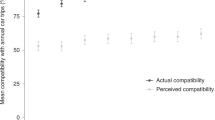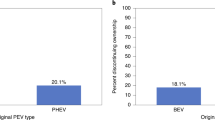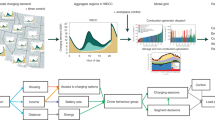Abstract
The carbon intensity of the electricity used to charge an electric vehicle (EV) is dependent on when in the day charging occurs. However, persuading EV owners to adopt incentives to charge during off-peak hours is challenging. Here we show that governments could exploit the ‘window of opportunity’ created when people purchase their first EV to promote time-of-use tariffs. Email recipients (n = 7,038 EV owners) were more likely to click-through to an information webpage when the email emphasized specific reductions in home-charging costs versus general bill savings. However, the ‘window of opportunity’ for maximizing potential adoption is short; email open rates declined from over 70% immediately after purchase to 40% for recipients owning their EV for over three months. These results demonstrate the potential of prompts to change behaviours for which opt-out enrolment (where enrolment is automatic unless people explicitly opt out) would be unethical or less effective.
This is a preview of subscription content, access via your institution
Access options
Access Nature and 54 other Nature Portfolio journals
Get Nature+, our best-value online-access subscription
$29.99 / 30 days
cancel any time
Subscribe to this journal
Receive 12 digital issues and online access to articles
$119.00 per year
only $9.92 per issue
Buy this article
- Purchase on Springer Link
- Instant access to full article PDF
Prices may be subject to local taxes which are calculated during checkout



Similar content being viewed by others
References
Knight, T., Kivinen, E. & Fell, D. Uptake of ultra low emission vehicles in the UK: a rapid evidence assessment for the Department for Transport 1–59 (Brook Lyndhurst, 2015).
Ma, H., Balthasar, F., Tait, N., Riera-Palou, X. & Harrison, A. A new comparison between the life cycle greenhouse gas emissions of battery electric vehicles and internal combustion vehicles. Energy Policy 44, 160–173 (2012).
Zarnikau, J., Zhu, S., Russell, R., Holloway, M. & Dittmer, M. How will tomorrow’s residential energy consumers respond to price signals? Insights from a Texas pricing experiment. Electr. J. 28, 57–71 (2015).
My Electric Avenue. My Electric Avenue Summary Report EA Technol. 1–9 (2015).
Klara, A. C. et al. Customer-Led Network Revolution High-Level Summary of Learning Electrical Vehicle Users 1–13 (CLNR, 2015).
Tran, M., Banister, D., Bishop, J. D. K. & McCulloch, M. D. Realizing the electric-vehicle revolution. Nat. Clim. Change 2, 328–333 (2012).
Braff, W. A., Mueller, J. M. & Trancik, J. E. Value of storage technologies for wind and solar energy. Nat. Clim. Change 6, 328–333 (2016).
Faruqui, A., Hledik, R. M., Levy, A. & Madian, A. L. Will smart prices induce smart charging of electric vehicles? SSRN Electron. J. 1–14 (2011).
Energy Market Investigation - Final Report 1–1417 (CMA, 2016); http://dx.doi.org/10.1002/9781118716571.ch6
Pichert, D. & Katsikopoulos, K. V. Green defaults: information presentation and pro-environmental behaviour. J. Environ. Psychol. 28, 63–73 (2008).
Ebeling, F. & Lotz, S. Domestic uptake of green energy promoted by opt-out tariffs. Nat. Clim. Change 5, 868–871 (2015).
Faruqui, A., Hledik, R. & Lessem, N. Smart by default: time-varying rates from the get-go not just by opt-in. Public Util. Fortn. 24–32 (2014).
Fenrick, S., Getachew, L., Ivanov, C. & Smith, J. Demand impact of a critical peak pricing program: opt-in and opt-out options, green attitudes and other consumer characteristics. The Energy Journal 35, (2014).
Thaler, R. & Sunstein, C. Nudge: Improving Decisions about Health, Wealth and Happiness (Yale Univ. Press, 2008).
Wells, J. Pension annuities: a review of consumer behaviour (Financial Conduct Authority, 2014).
Johnson, E. J. & Goldstein, D. G. Do defaults save lives? Science 302, 1338–1339 (2003).
Keller, P. A., Harlam, B., Loewenstein, G. & Volpp, K. G. Enhanced active choice: a new method to motivate behavior change. J. Consum. Psychol. 21, 376–383 (2011).
Sunstein, C. R. Impersonal default rules vs. active choices vs. personalized default rules: a triptych. Soc. Sci. Electron. Netw. 1–41 (2013).
Sunstein, C. R. & Reisch, L. A. Automatically green: behavioral economics and environmental protection. SSRN Electron. J. http://dx.doi.org/10.2139/ssrn.2245657 (2013).
Fenrick, S. A., Getachew, L., Ivanov, C. & Smith, J. Demand impact of a critical peak pricing program: opt-in and opt-out options, green attitudes and other customer characteristics. Energy J. 35, 1–24 (2014).
Cappers, P., Spurlock, C. A., Baylis, P., Fowlie, M. & Wolfram, C. Time-of-use as a default rate for residential customers: issues and insights. Lawrence Berkeley Natl Lab. LBNL-1005704 1–53 (2016).
Haynes, L. C., Green, D. P., Gallagher, R., John, P. & Torgerson, D. J. Collection of delinquent fines: an adaptive randomized trial to assess the effectiveness of alternative text messages. J. Policy Anal. Manag. 32, 718–730 (2013).
Verplanken, B., Walker, I., Davis, A. & Jurasek, M. Context change and travel mode choice: combining the habit discontinuity and self-activation hypotheses. J. Environ. Psychol. 28, 121–127 (2008).
Verplanken, B. & Roy, D. Empowering interventions to promote sustainable lifestyles: testing the habit discontinuity hypothesis in a field experiment. J. Environ. Psychol. 45, 127–134 (2016).
Thomas, G. O., Poortinga, W. & Sautkina, E. Habit discontinuity, self-activation, and the diminishing influence of context change: evidence from the UK understanding society survey. PLoS ONE 11, 1–16 (2016).
Verplanken, B. & Wood, W. Interventions to break and create consumer habits. J. Public Policy Mark. 25, 90–103 (2006).
Al-Ubaydli, O. & Lee, M. Can tailored communications motivate environmental volunteers? A natural field experiment. Am. Econ. Rev. 101, 323–328 (2011).
Rimer, B. K. & Kreuter, M. W. Advancing tailored health communication: a persuasion and message effects perspective. J. Commun. 56, S184–S201 (2006).
Next Green Car. Electric vehicle market statistics 2016—How many electric cars in UK? Next Green Car.com (2016); http://www.nextgreencar.com/electric-cars/statistics
Mail Chimp. Email marketing benchmarks Mailchimp.com (2016); https://mailchimp.com/resources/research/email-marketing-benchmarks
Benjamini, Y. & Hochberg, Y. Controlling the false discover rate: a practical and powerful approach to multiple testing. J. R. Stat. Soc. Ser. B 57, 289–300 (1995).
Wasserstein, R. L. & Lazar, N. A. The ASA’s statement on p-values: context, process, and purpose. Am. Stat. 1305, 129–133 (2016).
Hirst, E. & Brown, M. Closing the efficiency gap: barriers to the efficient use of energy. Resour. Conserv. Recycl. 3, 267–281 (1990).
Allcott, H. & Greenstone, M. Is there an energy efficiency gap? J. Econ. Perspect. 26, 3–28 (2012).
Gabaix, X. & Laibson, D. Shrouded attributes, consumer myopia, and information suppression in competitive markets. Q. J. Econ. 121, 505–540 (2006).
Allcott, H. Consumers’ perceptions and misperceptions of energy costs. Am. Econ. Rev. 101, 98–104 (2011).
Ajzen, I. The theory of planned behavior. Organ. Behav. Hum. Decis. Process. 50, 179–211 (1991).
Kormos, C. & Gifford, R. Validity of self-report measures of pro-environmental behavior: a meta-analytic review. J. Environ. Psychol. 40, 1–38 (2014).
Smith, N. C., Goldstein, D. G. & Johnson, E. J. Choice without awareness: ethical and policy implications of defaults. J. Public Policy Mark. 32, 159–172 (2013).
Frontier Economics. A framework for the evaluation of smart grids: a consultation document prepared for Ofgem. 1–50 (2011); http://www.frontier-economics.com/_library/publications/A framework for the evaluation of smart grids.pdf
Stern, P. C. et al. Opportunities and insights for reducing fossil fuel consumption by households and organizations. Nat. Energy 1, 16043 (2016).
Boudet, H. et al. Effects of a behaviour change intervention for Girl Scouts on child and parent energy-saving behaviours. Nat. Energy 1, 16091 (2016).
Kreuter, M. W., Lukwago, S. N., Brennan, L. K., Scharff, D. P. & Wadud, E. S. Effectiveness of tailored and non-tailored educational materials to promote nutrition label reading. Health Educ. 102, 271–279 (2002).
Littlechild, S. Retail competition in electricity markets—expectations, outcomes and economics. Energy Policy 37, 759–763 (2009).
Maltz, M. Psycho-Cybernetics (Prentice Hall, 1969).
Lally, P., van Jaarsveld, C. H. M., Potts, H. W. W. & Wardle, J. How are habits formed: modelling habit formation in the real world. Eur. J. Soc. Psychol. 40, 998–1009 (2010).
Nicolson, M. Electric vehicle owner engagement with tariff switching increased by tailored email prompts sent by government shortly after vehicle purchase: replication dataset and code. Figshare Figital Repository http://dx.doi.org/10.6084/M9.FIGSHARE.4696105.V1 (2017).
Acknowledgements
M.N. is funded by the EPSRC Centre for Doctoral Training in Energy Demand (LoLo), grant numbers EP/L01517X/1 and EP/H009612/1. G.M.H., D.S. and S.E. are supported by Research Councils UK (RCUK) Centre for Energy Epidemiology, grant number EP/K011839/1. We would like to thank Nicholas Brooks and Thomas Younespour at the UK Government Office for Low Emission Vehicles for the substantial contribution they made to executing the project.
Author information
Authors and Affiliations
Contributions
M.N. conceived, designed and implemented the research project, with substantial input on the design, analysis and interpretation of data from G.M.H. and D.S. G.M.H. provided critical revisions of the pre-analysis plan and critical revisions of the manuscript. D.S. also provided critical revisions of the manuscript. S.E. assisted with the creation of the data sharing agreement between UCL and the Office for Low Emission Vehicles and facilitated the introduction of the Energy Saving Trust into the project.
Corresponding author
Ethics declarations
Competing interests
The authors declare no competing financial interests.
Supplementary information
Supplementary Information
Supplementary Figures 1–3, Supplementary Tables 1–3. (PDF 381 kb)
Rights and permissions
About this article
Cite this article
Nicolson, M., Huebner, G., Shipworth, D. et al. Tailored emails prompt electric vehicle owners to engage with tariff switching information. Nat Energy 2, 17073 (2017). https://doi.org/10.1038/nenergy.2017.73
Received:
Accepted:
Published:
DOI: https://doi.org/10.1038/nenergy.2017.73
This article is cited by
-
My company is green, so am I: the relationship between perceived environmental responsibility of organisations and government, environmental self-identity, and pro-environmental behaviours
Energy Efficiency (2021)
-
Nudges for nudgers
Nature Energy (2018)
-
Energy use behaviour: A window of opportunity
Nature Energy (2017)



